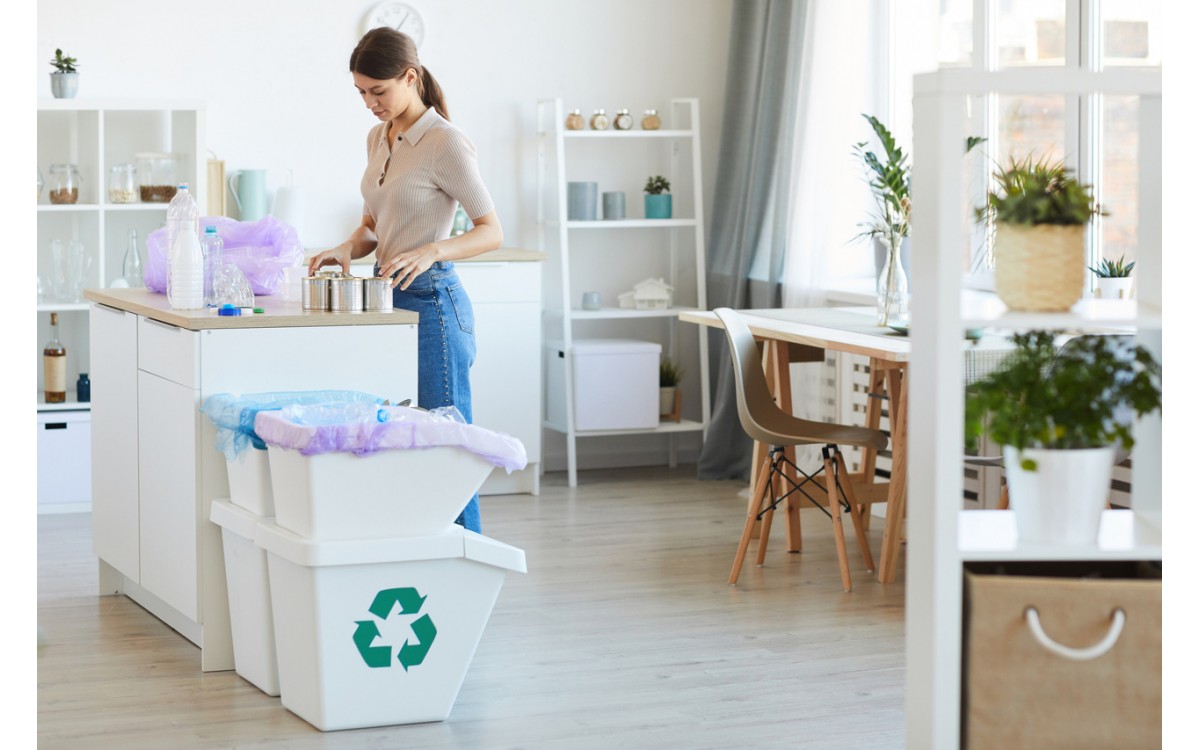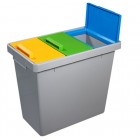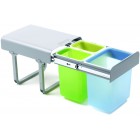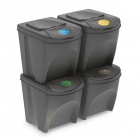Changing habits can be easier than you think. From this article, you will learn how to sort waste, whether it is mandatory, and which bins for sorting at home are the best to choose so that they look aesthetically pleasing and pass the test in everyday home life.
Waste segregation - what do we separate?
The main principle of the Uniform Waste Segregation System (UWSS) is to separate recyclable materials from those that unfortunately can no longer be used. Throughout the European Union, for order, a 5-bin segregation system is recommended:
- in blue containers we collect paper,
- in yellow metals and plastics,
- in green glass,
- in brown biodegradable waste,
- in black/gray mixed waste.
Home waste segregation should also follow this division, although within our four walls we obviously do not have to worry about the colors of the bins.
How to properly segregate waste?
- We throw into the paper container:
newspapers, catalogs, leaflets, notebooks, books, office/school paper, all printed sheets, paper packaging, cardboard, corrugated cardboard, paper bags.
Before throwing away remove all metal (e.g. staples) and plastic (e.g. handles) elements. - We throw into the metal and plastic container:
bottles after drinks, packaging after food products (also cans after preserves), multi-material packaging (e.g. cartons after juice and milk), packaging after cosmetics, packaging after cleaning products, caps, lids, aluminum foil, plastic bags.
Note, some plastic waste is too harmful to the environment, e.g. paint containers, electronic equipment, medicine packaging. We throw them into special containers for hazardous waste.
- We throw into the glass container:
glass packaging after drinks and food (also after vegetable oils), glass packaging after cosmetics.
Note, such products as porcelain, ceramics, eyeglass glass, heat-resistant dishes, candle holders, mirrors we throw into mixed ones. - We throw into the biodegradable waste container:
food leftovers, peelings and other vegetable and fruit waste, branches, leaves, flowers, mown grass, untreated wood, sawdust.
Note, we do not throw animal bones and feces, soil, stones, chipboard there.
Do you want to know what is made from recovered waste? We write about it in the article "What is recycling?".
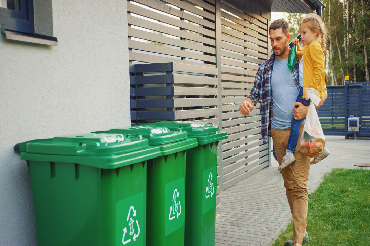
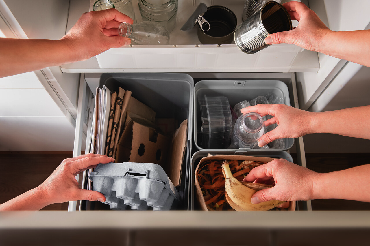
How to sort waste without going crazy - practical containers
When you are wondering which bins for sorting at home to choose, you should consider:
- Number of household members.
This will help you determine the capacity of the bins. In our offer you will find:- small, discreet containers up to 30 L,
- medium-sized bins from 30 to 60 L,
- large containers from 60 to 100 L,
- solid, certified external segregation containers for households: 120 L, 240 L, and even 360 L.
- Amount of waste produced.
Are you sure you need all 5 stations of the same size? Sometimes it is more ergonomic to choose a 2-compartment or 3-compartment container, and allocate smaller or larger freestanding containers for the remaining fractions. It all depends on your home preferences. You can compose waste bins for waste segregation at will, and ready-made smaller stations are easy to expand.
You decide which bin/which compartment in the station you will allocate for which waste. All you need is appropriate marking. Ready-made sets of stickers for 5 fractions or single pieces can be found in the section Stickers for segregation bins. All stickers are made of thick, laminated self-adhesive foil. - Space for bins.
If you plan to keep containers in kitchen cabinets, you have to choose from:- waste bins pulled out on sturdy metal frames, e.g. waste bin Ekko 1 x 16 + 2 x 8 L (40 cm),
- bins hung on doors (e.g. using a metal holder hooked on the top edge of the door, like cabinet bin 10 L simplehuman, or mounted on the inside of the door without loading the hinges, like cabinet bin 'SORT & GO' 2 x 12L - Brabantia),
- freestanding bins to be placed in the cabinet (e.g. waste bin Sesamo 2 x 8 L with integrated flap and removable inserts).
A full selection of this type of containers can be found in the category Waste bins for cabinets.
Sometimes, however, standard containers will not be the best. For the garage, garden or plot, stable, stainless steel bag stands may be much better. They are an economical, capacious (120 L), functional solution (they can always be folded to take up less storage space). Available models can be found in the tab Bag stands.
- Design. Visible containers can fit perfectly into the decor of your kitchen. In the category Waste bins you will find e.g.:
- slim, shiny Touch Bin rectangular waste bin 25L Brabantia with a quiet lid opened with one touch,
- elegant, matte Fireless 30 L waste bin with self-extinguishing lid,
- modern EKO 2 internal segregation container in bold, saturated colors.
The full offer of bins for home waste segregation can be checked in the category Internal segregation bins.
Biowaste - convenient waste segregation in the kitchen
We often have a lot of resistance to segregating bio-waste. It seems unhygienic due to unpleasant odors. The key to success is the choice of container:
- In the appropriate size.
Large households should think about professional containers with grates and ventilation grilles, e.g. bio waste container 120L with grate ESE.
Sometimes smaller bins will work better, e.g. Best Bin 53L bio segregation bin. The throw-in hole is in the frame, which serves as a practical, strong bag handle. Just remember to put on biodegradable bags - then you will be able to throw them away with bio-waste.
- From good materials.
For example, the Eko Komfort Bio 45L bio-waste container has a tight flap and perfectly smooth inner walls to facilitate cleaning of the bin. The material of the container is also resistant to corrosion.
All professional bins for this fraction can be found in the tab Bio-waste containers.
Waste segregation in a small kitchen
Small space can be a challenge, but it certainly does not stand in the way of comfortable waste segregation! Here are a few inspirations for waste segregation in a small apartment:
- compact containers arranged vertically, e.g. set of Easymax segregation bins 3 x 35L,
- efficient 3 in 1, e.g. 3-compartment Trioconcept 40L waste segregation bin with dimensions 50 cm x 29.6 cm x 30 cm [length x depth x width],
- mini station with independent lids, e.g. Net 3 x 20L internal segregation bin.
Home waste segregation - there is no need to wait
Detailed information on proper waste segregation can always be found on the website of your municipality. If you have any doubts about choosing the right containers - we invite you to contact us!









 Waste Containers
Waste Containers Waste Bins
Waste Bins Street And Park Waste Bins
Street And Park Waste Bins Sand And Salt Containers
Sand And Salt Containers Hazardous Waste Containers
Hazardous Waste Containers House And Garden
House And Garden Park Benches
Park Benches

